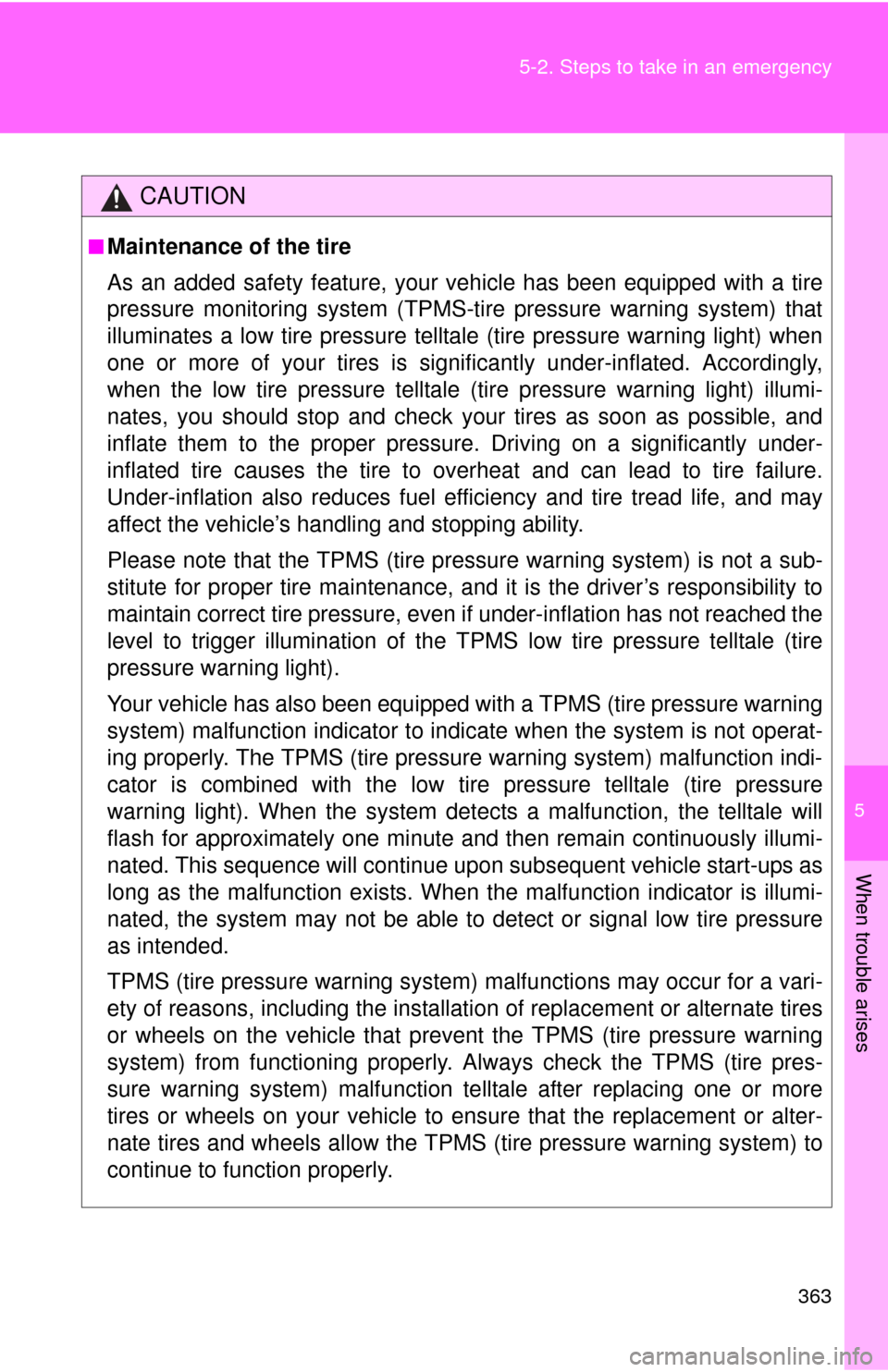Page 364 of 439

5
When trouble arises
363 5-2. Steps to take in an emergency
CAUTION
■Maintenance of the tire
As an added safety feature, your vehicle has been equipped with a tire
pressure monitoring system (TPMS-tire pressure warning system) that
illuminates a low tire pressure telltale (tire pressure warning light) when
one or more of your tires is significantly under-inflated. Accordingly,
when the low tire pressure telltale (tire pressure warning light) illumi-
nates, you should stop and check your tires as soon as possible, and
inflate them to the proper pressure. Driving on a significantly under-
inflated tire causes the tire to overheat and can lead to tire failure.
Under-inflation also reduces fuel efficiency and tire tread life, and may
affect the vehicle’s handling and stopping ability.
Please note that the TPMS (tire pressure warning system) is not a sub-
stitute for proper tire maintenance, and it is the driver’s responsibility to
maintain correct tire pressure, even if under-inflation has not reached the
level to trigger illumination of the TPMS low tire pressure telltale (tire
pressure warning light).
Your vehicle has also been equipped with a TPMS (tire pressure warning
system) malfunction indicator to indicate when the system is not operat-
ing properly. The TPMS (tire pressure warning system) malfunction indi-
cator is combined with the low tire pressure telltale (tire pressure
warning light). When the system detects a malfunction, the telltale will
flash for approximately one minute and then remain continuously illumi-
nated. This sequence will continue upon subsequent vehicle start-ups as
long as the malfunction exists. When the malfunction indicator is illumi-
nated, the system may not be able to detect or signal low tire pressure
as intended.
TPMS (tire pressure warning system) malfunctions may occur for a vari-
ety of reasons, including the installation of replacement or alternate tires
or wheels on the vehicle that prevent the TPMS (tire pressure warning
system) from functioning properly. Always check the TPMS (tire pres-
sure warning system) malfunction telltale after replacing one or more
tires or wheels on your vehicle to ensure that the replacement or alter-
nate tires and wheels allow the TPMS (tire pressure warning system) to
continue to function properly.
Page 367 of 439
366 5-2. Steps to take in an emergency
Remove the flat tire and replace it with the spare provided.
■Before jacking up the vehicle
●Stop the vehicle on a hard, flat surface.
●Set the parking brake.
●Shift the shift lever to P (automatic transmission) or R (manual
transmission).
●Stop the engine.
●Turn on the emergency flashers.
■Location of the spare tire, jack and tools
■To o l s
*: Vehicles with rear view monitor system
Tool bag
Jack
Spa r e t ire
Jack handleExtensionWheel nut
wrenchRemover*
Wrench*
Page 368 of 439
5
When trouble arises
367 5-2. Steps to take in an emergency
Taking out the jack and tool bag
Remove the cover and loosen
the strap.
Loosen and remove the jack.
Tighten
Loosen
Taking out the spare tire (vehicles without rear view monitor system)
Vehicles with an aluminum
wheel: Remove the wheel orna-
ment using the wheel nut wrench
as shown.
To protect the wheel and wheel
ornament, place a rag between
the wheel nut wrench and the
wheel ornament, as shown in
the illustration.
Page 369 of 439
368 5-2. Steps to take in an emergency
Turn the hold-down nuts counter-
clockwise with the wheel nut
wrench and remove them.
Taking out the spare tire (vehicles with rear view monitor system)
Remove the bolt cover.
Bolt cover
Remove the bolt which fixes the
spare wheel cover using the
wrench in the tool bag
(P. 364).
Page 370 of 439
5
When trouble arises
369 5-2. Steps to take in an emergency
Remove the spare wheel cover.
Turn the hold-down nuts counter-
clockwise with the wheel nut
wrench and remove them.
Page 371 of 439
370 5-2. Steps to take in an emergency
Replacing a flat tire
Chock the tires.
Flat tire
Wheel
chock
positions
FrontLeft-
hand
sideBehind the
rear right-
hand side
tire
Right-
hand
sideBehind the
rear left-
hand side
tire
RearLeft-
hand
sideIn front of
the front
right-hand
side tire
Right-
hand
sideIn front of
the front
left-hand
side tire
Page 372 of 439
5
When trouble arises
371 5-2. Steps to take in an emergency
Remove the wheel ornament using the wheel nut wrench or
the remover as shown.
To protect the wheel and wheel ornament, place a rag between the
wheel nut wrench or the remover and the wheel ornament, as shown
in the illustration.
Aluminum wheel
Steel wheel
Slightly loosen the wheel nuts
(one turn).
Page 373 of 439
372 5-2. Steps to take in an emergency
Position the jack at the correct
jack point as shown.
Front
Rear
Make sure the jack is positioned
on a level and solid place.
Assemble the jack handle exten-
sion as shown. Be sure to tighten
each bolt securely.
Raise the vehicle until the tire is
slightly raised off the ground.
When positioning the jack under
the rear axle housing, make
sure the groove on the top of
the jack fits with the rear axle
housing.
Remove all the wheel nuts and
the tire.
When resting the tire on the
ground, place the tire so that the
wheel design faces up to avoid
scratching the wheel surface.
Front